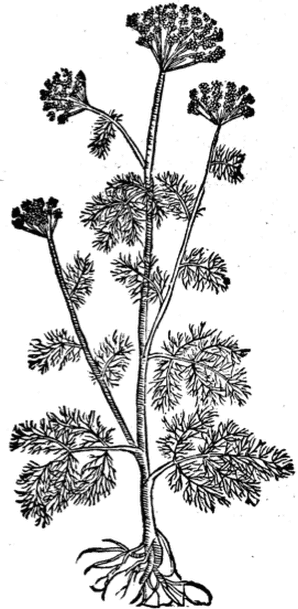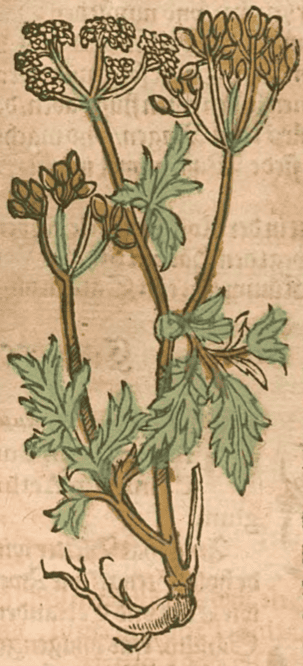Cuminum, CuminSweta Jiraka (Ayurveda)Cirakam (Siddha) Zeera Safaid (Unani) Zi ra dkar po ཟི་ར་དཀར་པོ (Tibetan) |

|

|

|
|
Della Materia Medicinale, Andrea Valuassori, 1562 |
Krauterbuch, Lonitzer, 1578 |
Botanical name:
Cuminum cyminum
Four Kinds were described in Unani:
- Farsi, or Persian
- Nabti, Nabathean
- Kirmani, Black Cumin
- Shami, or Syrian
Parts used:
Seed
Temperature & Taste:
Very Warm, dry. Pungent
“Cumin is hot in the second and dry in the third degree”. (Avicenna)
Classifications:
2C INCIDERS. 2D ATTENUATERS OF CONGEALED BLOOD. 2H. CARMINATIVE. 2Q. ANODYNE
3C. ALEXIPHARMIC. 3F. LITHONTRIPTIC. 3H. LACTAGOGUE. 4e. STOMACHIC. 4f. SPLENETIC. 4g. HEPATIC
Uses:
1. Warms the Stomach, Moves Qi:
-Wind, Colic, Bloating, Tympanites (Edema with wind)
-Food Stagnation
-Malabsorption
-used to aid slimming
2. Warms the Lungs, clears Phlegm, stops Cough:
-common Cold, hoarseness
-Cough, Asthma, shortness of Breath, Pleurisy (Electuary with Honey or boiled in wine with Figs)
-“According to Galen its oral intake with vinegar and water is useful in Dyspnea” (Avicenna)
-“useful for treating Breathlessness” (Avicenna)
3. Settles Wind, Benefits the Head:
-Headache, Migraine, Dizziness, Vertigo etc. (Salmon)
–Insomnia, Amnesia (taken with Honey)
-“The extract of wild cumin improves eye-sight” (Avicenna)
-Cold Palpitation (Avicenna)
4. Warms the Kidney, Clears Damp, Promotes Urine:
-Edema, Renal Colic, urinary complaints including Incontinence
-Arthritis, Gout
-Gonorrhea
-the oil has been given for Stones
–Regarded as Aphrodisiac
5. Benefits in Pregnancy, Promotes Milk:
-taken throughout Pregnancy to aid Fetal development, relieve Morning Sickness and promote easier Childbirth (Ayurveda)
-promotes Milk postpartum
-it has developed a reputation to increase Breast size
6. Moves the Blood, Promotes Menstruation:
-Amenorrhea, Dysmennorhea
-large doses promote Miscarriage
-also for Blood stagnation, Bruising
7. Resists Poison:
-Slow, Persistent Fevers (Ayurveda)
-Snake bite (decocted in wine)
-topically for Scorpion bites (Ayurveda)
-Insect Bites (Avicenna)
8. Externally:
-a plaster (made with wine and Barley meal) is applied to Stitches and pains of the Sides; also to the abdomen for Colic.
-applied topically to joint pain, as well as swellings of the Joints, Breast or Genitals
-applied as a paste to Boils and Scorpion stings in Ayurveda.
-Boiled in Wine and made into a poultice for Swellings of the Testicles caused by Wind or Water.
-Unani texts state it ‘destroys’ pterygium
-“Washing with it cleanses the face” (Avicenna)
-“Finely powdered cumin… heals the Wounds” (Avicenna)
-applied to Bruising and blood spots in or around the Eye (Avicenna)
-Scabies, Pterygium: “It is chewed with salt to enable it to get mixed up with saliva. In this form it is applied in cases of Scabies, Pterygium” (Avicenna)
Dose:
Powder: 500mg–3 grams
Decoction: 2–6 grams
Preparation:
1. Roasted Cumin
Cumin seed is sometimes roasted in India. This moderates its heat and pungency, and is often eaten after a meal to help digestion.
2. Vinegar-prepared Cumin:
Cumin seed is steeped 3 days in viengar, then dried. This makes it strong to settle Wind, moderates its Heat, and also leads its effect more strongly to the Liver. It was also chewed to mitigate Vertigo.
Corrective:
Tragacanth (Unani)
Substitutes:
1. Ammi seed
2. Carum copticum
3. Nigella seed
Main Combinations:
Digestion:
1. Indigestion, Colic, Food Stagnation, Cumin with Long Pepper, Rue and Saltpeter (as in Lesser Cumin Composition of Galen)
2. Indigestion, Bloating, Colic, Bowel Pain:
i. Cumin with Fennel, Coriander, Cardamon
ii. Cumin with Cinnamon, Clove, Galangal, Calamint, Ginger, Black Pepper, Cardamon (as in Powder of Cumin Greater of Nicholas)
iii. Cumin with Ginger, Cinnamon, Clove, Aloeswood, Galangal, Long Pepper, Cardamon (as in Electuary of Cumin of Mesue)
iv. Cumin with Aniseed, Fennel seed, Caraway, Camomile, Raisin (as in Carminative Decoction)
3. Loss of Appetite, Cumin with Ammi, Cardamon, Mastic (as in Powder for Loss of Appetite of Nicholas)
4. Hiccup, Cumin with Long Pepper in Honey (Ayurveda)
5. Stomach Pain, Cumin with Camomile, Rue, Marjoram, Pennyroyal, Rosemary, Aniseed, Fennel seed (as in Decoction for Stomach Pain)
Lungs:
6. Cough, Asthma, shortness of Breath, Pleurisy, Cumin with Figs, decocted in wine (Gerard)
7. Cough with Cold Phlegm, Cumin, Long Pepper, Licorice (Ayurveda)
8. Hoarseness and Loss of Voice:
i. Cumin roasted with Mustard seed, Black Pepper, Calamint, Pyrethrum (as in Electuary to Clarify the Voice of Galen)
ii. Cumin with Tumeric, Calamus, Costus, Long Pepper, Ginger, Licorice, Rock Salt (as in Kalya Avaleha of Ayurveda)
Other:
9. Renal Colic, Cumin with Caraway and Black Salt (Ayurveda)
10. Gout, Cumin with Caraway and Coriander seed (Ayurveda)
11. Vertigo:
i. Cumin with Coriander, Calamus, Marjoram, Aniseed, Fennel seed (as in Sugar for Vertigo of Gabelhover)
ii. Cumin with Nutmeg, Coriander seed, Mistletoe, Peony seed, Galangal, Calamus, Betony (as in Powder of Nutmeg for Vertigo)
12. Aphrodisiac, Cumin with Black Pepper and Honey (Unani)
13. Menstrual pain, Cumin with fresh Ginger and Valerian (Ayurveda)
14. To aid Fetal development, relieves Morning Sickness and promote easier Childbirth, decoct Cumin in Milk and add Honey. (Ayurveda)
15. To promote Milk, Cumin with Ammi, Fennel, Shatavari. (Ayurveda)
16. Insect Bites, Cumin with Rue (Avicenna)
Externally:
17. Bruising, Congealed Blood, Cumin, Salt (1 oz. each), Honey (4 oz.) Beat the Cumin and Salt then heat with the Honey and apply warm. (The Secrets of Alexis, 1615)
18. Abscess of the Testicles, Cumin powder, Raisin pulp, Bean meal mixed with Honey and applied. (The Secrets of Alexis, 1615)
19. Orchitis, Cumin, Bean meal with Olive oil is applied (Avicenna)
Major Formula
Carminative Decoction
Carminative Decoction (Pharm. Dogmaticum)
Lesser Cumin Composition (Galen)
Powder of Cumin Greater (Diacyminum) (Nicholas)
Electuary of Cumin (Diacyminum) (Mesue)
Powder of Cinnamon Compound (Mesue)
Powder for Loss of Appetite (Nicholas)
Electuary for Gastric Pain
Cautions:
1. Avoid large doses during Pregnancy.
2. Not used in Hot or Bilious constitutions
3. Ancient writers said continual taking of Cumin causes paleness. However, Avicenna said “Its excessive use, however,
imparts a yellow colour to the body”.
Main Preparations used:
Distilled Water of the Seeds, Distilled Oil, Species Diacuminum
